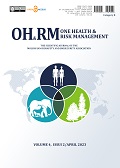Abstract
Introduction. Traumatic brain injuries are a significant public health issue in both developed and developing countries. In Georgia, traumatic brain injuries remain one of the leading causes of mortality and disability. Traumatic brain injuries affect families, communities and societies in Georgia and have far-reaching human, social and economic costs, manifested in increased emergency department visits, hospitalizations, disability and deaths. The aim of this study is to retrospectively analyze the epidemiological features of Traumatic Brain Injuries on the example of Medical Centre in Georgia which provides a first level trauma care for patients in the country. Material and methods. Retrospective observational study was conducted from August 1 to October 31, 2018. The study included patients who were admitted with a Traumatic Brain Injuries diagnosis and S00-S09.0 codes (ICD 10). SPSS 20 was used for statistical analysis. Results. A total of 96 TBI-related hospitalizations were studied. 56.3% (n=54) of hospitalized patients were males. The average age of patients was 40.7 years. Furthermore, patients aged 25-44 years were more represented in the number of TBI-related hospitalizations (39.6%). 95.8% of all Traumatic brain injuries hospitalizations were as a result of unintentional injuries. Unintentional falls were shown to be the predominant mechanism of injury accounting for over half of TBI-related hospitalizations (56.2%). The second most common mechanism of injury is the road traffic injury, mostly occurring among males (63.9%). Conclusions. This study offers an insight into understanding the epidemiological features of Traumatic Brain Injuries on the example of the National Medical Center from Georgia.
|
 Views: 515|
|
Views: 515|
|
This work is licensed under a Creative Commons Attribution 4.0 International License.

